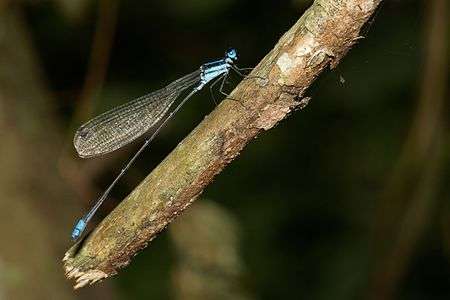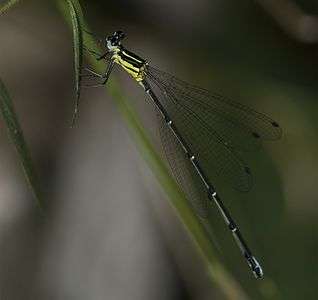Caconeura ramburi
Caconeura ramburi[2][1] is a damselfly species in the family Platycnemididae. It is commonly known as the Coorg Bambootail[3] or Indian blue bambootail.[4] It is endemic to Western Ghats.[1][5]
| Caconeura ramburi | |
|---|---|
 | |
| male | |
 | |
| female | |
| Scientific classification | |
| Kingdom: | |
| Phylum: | |
| Class: | |
| Order: | |
| Family: | |
| Genus: | Caconeura |
| Species: | C. ramburi |
| Binomial name | |
| Caconeura ramburi (Fraser, 1922) | |
| Synonyms | |
| |
Description and habitat
It is a medium sized damselfly with black-capped blue eyes. Its thorax is black on dorsum and azure blue on the sides. There is a very narrow azure blue antehumeral stripe and a narrow black stripe on the postero-lateral suture on each side. Wings are transparent with black, diamond shaped pterostigma. Abdomen is black with azure blue stripes on segment 1 and 2. Segment 3 to 7 have broad basal rings in azure blue. Segments 8 to 10 are azure blue on dorsum, with black basal annules. The lateral side of segment 10 is black. Female is similar to the male; but the markings more greenish-blue or even yellow, except in very old specimens.[6]
It is larger and more slender insect than Caconeura gomphoides and breeding at a lower altitude. The broad blue basal annules will help to distinguish it. The larger size, differently shaped pterostigma, the absence of a ventral spine on the base of the superior appendages, and the underside of the head entirely black, will help to distinguish it from Caconeura risi.[6]
It breeds in forest streams. Commonly found perched on riparian vegetation along shaded streams.[6][7][8][3][4]
See also
- List of odonates of India
- List of odonata of Kerala
References
- Dow, R.A. (2009). "Caconeura ramburi". IUCN Red List of Threatened Species. 2009: e.T163596A5621033.
- Martin Schorr; Dennis Paulson. "World Odonata List". University of Puget Sound. Retrieved 12 Oct 2018.
- "Caconeura ramburi Fraser, 1922". India Biodiversity Portal. Retrieved 2017-03-10.
- "Caconeura ramburi Fraser, 1922". Odonata of India, v. 1.00. Indian Foundation for Butterflies. Retrieved 2017-03-10.
- K.A., Subramanian; K.G., Emiliyamma; R., Babu; C., Radhakrishnan; S.S., Talmale (2018). Atlas of Odonata (Insecta) of the Western Ghats, India. Zoological Survey of India. pp. 94–95. ISBN 9788181714954.
- C FC Lt. Fraser (1933). The Fauna of British India, including Ceylon and Burma, Odonata Vol. I. Red Lion Court, Fleet Street, London: Taylor and Francis. pp. 254–256.
- C FC Lt. Fraser (1924). A Survey of the Odonate (Dragonfly) Fauna of Western India with Special Remarks on the Genera Macromia and Idionyx and Descriptions of Thirty New Species (PDF). Zoological Survey of India. Volumes (Records). p. 505.
- Subramanian, K. A. (2005). Dragonflies and Damselflies of Peninsular India - A Field Guide.
External links
![]()
![]()
